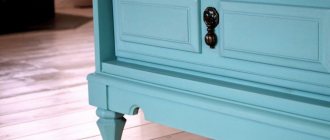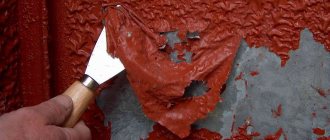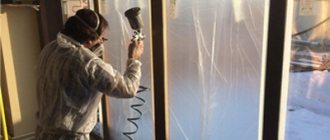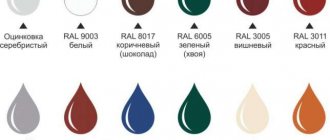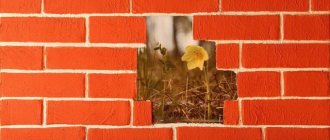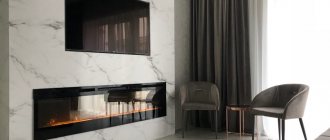Key factors that can pose a threat to wood furniture are high humidity, exposure to UV rays, temperature changes, mechanical damage, fungus and mold. To create maximum protection and attractiveness, special paints and varnishes are used. How to paint old furniture so that it lasts for some time without irritating the eye or spoiling the overall picture of the interior? It’s very simple, and there are many restoration methods. Let's look at the simplest and most accessible ones. But first, let’s figure out what needs to be done for this, what tools and consumables to stock up on.
What kind of furniture can be repainted?
Thanks to modern paint and varnish coatings, any furnishings and garden furniture can be updated:
- wooden;
- metal;
- plastic;
- from pressed sawdust;
- varnished;
- laminated.
You can repaint modern and Soviet furniture. The laminate and varnish are completely removed using a grinder with a circular attachment. It is enough to sand smooth surfaces to make them rough.
How to repaint an old Soviet table with your own hands - remodeling inside and out
Watch also the promised video - how to repaint an old varnished table with your own hands and turn it into a new bright and stylish one.
Also a few more photos of the finished result.
Share your opinion below in the comments, did you like the remake? Would you like more articles or videos like this? You can also ask your questions! I read everything and respond as best I can.
For those who like to draw, I also recommend the article - How to draw with sketching markers, step-by-step lessons for beginners
What you need for work
Approximate list of materials and tools:
| Inventory | Description |
| Dye | In cans or aerosols |
| Varnish | Glossy, matte or semi-matte |
| Putty, primer | Same base as paint |
| Sandpaper | Coarse and fine grain |
| Plastic bath | For paint |
| Paint brush | With synthetic bristles, for painting small parts |
| Roller | Short pile, for large surfaces |
| Small rubber spatula | For spreading putty |
| Screwdriver | For dismantling prefabricated objects - tables, sofas, cabinets |
| Masking tape | Paste over fixed fittings |
| Newspapers, plastic film | Place under the product |
You will also need gloves and safety glasses for work if the paints and varnishes emit a pungent odor.
Let's get ready
Tools and materials
Very often, furniture that was produced in the USSR is of such high quality that it can last for many years, which cannot be said about many modern models. In addition, vintage-style home furnishings are now more popular than ever before. For this reason, painting furniture to look like wood would be an ideal solution.
But how to do everything without noise and dust, and at the same time not turn your favorite apartment into the abode of an incompetent painter, which can smell of all kinds of toxic products? To do this, you will need to purchase special tools and materials.
For painting you will need the following:
- Paint for painting wooden furniture.
- Gloves.
- Paint tray.
- Furniture that is subject to restoration.
- Masking tape.
- Brushes or roller.
Before you begin, you should prepare the furniture. For this you will need:
- Protective glasses.
- Gloves.
- Rubber spatula.
- Paint tray.
- Brushes or roller.
- Glasses for protection.
- Fine grit sandpaper.
- Wooden block or sanding machine.
When you have prepared all the tools and materials, you can begin. But before painting, it is worth bringing the furniture into proper condition so as not to make mistakes when painting.
Preparing furniture for painting
Proper preparation is the key to success. For this reason, you should carefully read the instructions and do everything exactly as described so that after painting you get the desired effect.
- First, inspect the furniture you want to restore for minor damage. If necessary, you can repair or replace some of the mechanisms, such as hinges, handles and locks. If the varnish on the furniture begins to peel, it should also be removed. Then remove all the doors, remove the drawers and unscrew the locks and handles.
- When everything is disassembled, you can begin sanding all surfaces (including glossy and matte) with sandpaper. It is the finely coated sandpaper that will not leave scratches that will be difficult to prime or paint over. For convenience, you can use a grinding machine.
- Next, we coat the furniture with a primer, first the surfaces, and then you can seal the problem areas with putty. This will give good grip. The surface can be degreased with alcohol or vodka - they will not leave a slippery film on the furniture.
- In order for painting wood furniture to be successful, you should not neglect the next step. You need to apply an acrylic primer and thoroughly saturate all minor damage such as scratches and cracks. To do this, use a brush. Next, wait for it to dry completely.
- Arm yourself with a rubber spatula and putty to hide any remaining defects.
- After drying, sand the areas where the primer and putty were applied. To do this, you can use sandpaper or a sanding machine. Depending on the depth of the defects and the layer of material, this operation may have to be repeated several times.
- At the end of the work, prime everything and get rid of dust.
Advice! When choosing a primer, try to choose a shade that will closely match the shade of the furniture. This will not only make the color even, but also make it possible to save on paint.
Which paint to choose
The paint for painting wooden furniture must be chosen correctly. To do this, you should pay attention to the material of manufacture. There are many varnishes that will help not only give the desired shade to surfaces, but also protect against parasites, moisture and dirt.
Article on the topic: How to care for veneer furniture
The following types of varnishes are usually used:
- Epoxy.
- Oily.
- Alcohol.
- Alkyd.
- Polyurethane.
- Nitrocellulose.
Unlike paint, varnish adds durability and hardness to the surface. But if you have not yet decided on what paint to paint your furniture, make a choice in favor of any paint from the list below:
- Acrylic paints are traditional among furniture finishing products. They dry quickly, are durable, convenient to use and are great for treating furniture that will be placed in the kitchen and children's room. In addition, acrylic paints do not have a strong odor and are easy to dilute with water, which makes it possible to save money.
- Acrylic paints in cans will make the work easier and simplify the process. This paint applies smoothly to the surface and dries faster than those applied with a brush or roller.
- Lacquer enamel paints, when applied to wood, add gloss and shine. If you want to achieve a matte finish, oil-based paints will help you.
- To preserve the structure of a wooden surface, use transparent paints. The range of these is large, and the consistency makes it possible to mix a variety of shades to get what you need.
Stages of painting (using the example of a kitchen cabinet)
Most likely, you are thinking about one or another piece of furniture that can be painted. Very often these are kitchen cabinets, since they suffer from mechanical stress and moisture more than other furniture. Let's use a kitchen cabinet as an example to paint wooden furniture with our own hands.
Please note that when buying unfinished kitchen cabinets, 8 out of 10 times you will find birch. This wood has a fine-grained structure, and stain will look great on it. For example, when using a stain with a cherry tint, you can easily achieve a cherry color.
Stage No. 1: sanding the wood. This is the most important stage in preparation. Use 120 grit sandpaper and you can easily sand the wood. It is important to do this in the direction of the texture to avoid scratching. Next, take 220-grit sandpaper and sand the surface again to remove scratches and create a smooth surface.
Article on the topic: How to care for plastic furniture
Stage No. 2: impregnation of wood. To apply impregnation, you should thoroughly wipe the dust from the surface. In this case, the impregnation will serve as a sealant and promote uniformity during painting. After application, you need to wait until it dries completely.
Stage No. 3: applying stain. Ideally, it should be applied with a brush and in circular motions so that the product is well rubbed into the wood texture. Apply the final coat in the direction of the texture to obtain a perfectly smooth surface.
Stage No. 4: coloring. Paint, as such, will not protect the surface from moisture, drying and parasites. For this reason, you should study the composition of the paint in advance, since you will probably have to purchase additional additives for the protective layer.
Preparatory work
To ensure an even coating, the surface must be properly prepared for painting.
Visual inspection
Before work, assess the condition of the piece of furniture. Old chairs, sofas and armchairs often need to be reupholstered. Before painting, you also need to fix wobbly legs and squeaky doors.
Removing old coating
In addition to sandpaper and the sanding attachment of the grinder, varnish is removed from furniture using solvents or heated with a hair dryer, and then cleaned off. But the easiest way to roughen a smooth surface is by sanding it with sandpaper.
Sanding
Wooden furniture is sanded along the grain lines. For better adhesion, the metal surface is degreased with acetone, alcohol or white spirit.
Puttying and priming
Deep cracks, chips and scratches that could not be smoothed out with sandpaper are covered with putty. For durable coating, latex compounds are used that form elastic compounds. As a result, the paint will not crack due to temperature changes.
Expert opinion
Zakharova Irina Yurievna
Cleaning professional with 15 years of experience. Our best expert.
Ask a Question
For metal, an anti-corrosion primer is used, and for previously painted surfaces, deep penetration compounds are used.
Before applying the primer, areas with putty are sanded again. A surface coated with a water-based primer should not be wiped with a damp cloth before painting.
See also
How can you paint plastic, top 5 suitable compositions and how to apply
Protect yourself and the premises
The smell of paint can not only give you a headache, but also poison you. Wear a respirator while working, especially if sanding or spraying paint or varnish. It's ideal to paint outdoors, but this isn't always possible, so keep windows open or ventilate as often as possible while decorating.
It is also important to protect the room: the most reliable way is to cover the floor and furniture with film secured with tape. However, if you paint and apply varnish with brushes and rollers rather than using a spray can, covering the floor under furniture may be sufficient protection.
How can I repaint it?
You can update the appearance of old furniture using coloring compounds, tinting primer or varnish.
Primer
To paint wooden furniture you will need a special primer. The coating ensures reliable adhesion of the paint to the surface and has antiseptic properties. Compositions of a similar shade and from the same manufacturer are best in contact with each other. Due to differences in binding components in primer and paint from different companies, the strength of the coating is reduced.
Advantages and disadvantages
if you want to change the color of the product again, the surface is already ready for use;
easy to apply;
no need to dilute.
does not hide surface defects;
not resistant to damage.
Water-based soil will not withstand wet cleaning.
Stains, varnishes, waxes
Types of varnishes that can be used for furniture:
- water;
- nitro varnish;
- shellac;
- polyurethane.
Advantages and disadvantages
Durable coating is resistant to damage.
compositions must be diluted with solvents;
unpleasant smell.
Nitro varnish lasts longer on wooden decorations. Shellac creates an ideal glossy surface. Tinting varnish will make light wood several shades darker. Wax protects the surface, adds shine and tint. Special tinting and transparent impregnations emphasize the structure of wood or imitate expensive species on wooden surfaces. The most durable is ship varnish.
But it cannot be used indoors or on furniture due to the toxic substances it contains, which continue to evaporate for many years after application.
Paints
The following compositions are suitable for painting old furniture:
- water-based acrylic - allow air to pass through, preventing the appearance of fungus, do not smell;
- alkyd - resistant to moisture, suitable for bathroom furniture;
- oil ones are the most durable.
Advantages and disadvantages
several layers hide small surface defects;
most formulations are safe for health;
various application methods - roller, brush, spray gun;
wide selection of colors;
white compositions can be colored in any shade.
color may change under natural and artificial light.
To highlight decorations, you can use spray paints in metallic shades.
When choosing white paint, you need to pay attention to its shade. It comes in warm and cold tones. Red, orange and yellow pigments are added to warm tones, and blue and green to cool tones. You should also consider lighting, as white tones look different in a dark and light room. For example, white with a purple tint appears pink.
Types of paint for furniture
- Acrylic. Acrylic compositions can be water-based or varnish-based; they do not have an unpleasant “chemical” smell, dry quickly enough, and are safe for health. Painting old furniture with acrylic paint is suitable when working with solid objects, as well as chipboard and MDF. To protect materials from mold, acrylic paints contain an antiseptic, which also extends the life of the product. Primary colors are matte, close to natural; furniture acrylic paints in bright colors are rare.
- Alkyd. Alkyd paints with moisture-repellent properties are no less popular. They are permeable to steam, dry quickly and are used economically. The main component is alkyd resins, into which solvents based on polyhydric alcohol are introduced. Suitable for working with objects made of wood, plywood, chipboard.
- Drying oil based paints. To prepare oil-based paint for painting furniture, drying oil and vegetable fats are used. Easy to use, it has an unpleasant odor, which is why it is often chosen for working with objects outdoors. Such compositions are gradually losing popularity because they take a very long time to dry, can become cracked due to UV rays, and are also not permeable to steam. The only area in which they are indispensable is painting in a vintage style.
- Latex. Latex compositions made on a water-emulsion basis are good. They contain artificial latex. Such options penetrate well into the structure of the wood, creating a film on the surface that allows the wood to “breathe.” Often used for restoration of veneer products.
- Silicone. Silicone compounds are considered the most stable, but they are expensive. By creating a protective film on the surface, they do not interfere with normal air circulation. The advantage of this paint for painting old furniture is that the color will last for a long time.
Step-by-step instructions for repainting
Stages of work:
- wash the item with water and detergent;
- after drying, disassemble into separate elements, remove handles, take out drawers, unscrew legs;
- treat with fine-grained sandpaper to smooth out roughness and remove the old coating;
- cover large cracks with putty;
- stick masking tape on parts that do not need to be painted;
- coat with primer;
- apply paint;
- After the first layer has dried, apply the second, and then, if necessary, the third.
See also
The best way to paint heels on boots, what you need and how to apply
When the paint is completely dry, the furniture is varnished. Metal frames are also sanded, covered with a metal primer, and then painted.
Important to consider
You can paint furniture with a brush or spray
To carry out all painting work correctly, you need to adhere to a number of subtleties. Knowing them, you can not only effectively cope with the task in the shortest possible time, but also rationally save your budget.
Some useful tips that will help you paint your furniture efficiently:
- Selection of materials - give preference to products from a popular, consumer-tested manufacturer: this will not only make it easier to decide on the best option for painting, but also achieve greater compatibility of materials. Before purchasing, be sure to read the instructions.
Materials and tools for painting furniture
- Experiment with a palette of colors - correctly selected, compatible colors will bring fresh, extraordinary notes to the space of the room and help visually expand it. Playing on the contrasts of the colors of walls and furniture, you are free to bring to life any of your creative ideas.
Palette of colors and shades for painting furniture
- Buy brushes and a roller for painting work - the tools should have different thicknesses: it will be easier to thoroughly paint hard-to-reach places. The roller is useful for painting surfaces with a wide area; brushes are indispensable for painting hard-to-reach places: corners of furniture, removable parts of fittings, etc.
For painting small areas of furniture, a brush is suitable, but for large-scale work it is better to choose a roller or spray gun.
- Painting tape - will protect the surface from accidental paint on an already applied layer.
In situations where the stain has already appeared, using a solvent will ruin the freshly applied paint (which is extremely unpleasant), and you will have to repaint the specific area. Using masking tape is the best option for you. Masking tape to protect unpainted parts
- Wear protection - be extremely careful when working with paint, as the fumes have a detrimental effect on the respiratory system. Don't forget to wear a respirator mask. Hands, like other parts of the body, also need to be protected from ingress of dye, since the composition may be toxic. Upon completion of work, thoroughly ventilate the room.
Protective equipment that may be needed for furniture restoration
Varnishing
Apply 2-3 layers of varnish to the painted and cleaned surface. Each layer must dry for at least 40 minutes. For varnishing, brushes are used or a special tampon is made - cotton wool is dipped into the composition and wrapped in linen cloth. The coating is applied evenly, using blotting movements and in any direction.
Painting
Use a small roller to apply three thin coats of latex paint . Allow six to eight hours between coats . It is important that you sand the surface between coats if you have any drips or debris under the paint. This important step contributes to creating an ideal surface in the end.
Photography – earthbornpaints
How to paint antique
To artistically age a freshly painted surface, you will need candle wax and a knife.
How to create a vintage effect:
- clean the painted sides of the object from dust and sand;
- coat with a transparent primer;
- rub protruding parts, corners, edges with wax;
- cover with paint;
- after drying, scrape the waxed areas with a knife;
- smooth the surface with sandpaper.
Because of the wax, the paint does not adhere well to the surface and is easily removed, resulting in the effect of a coating worn away by time.
The second way to age wooden furniture:
- cover the cleaned surface with a thin layer of white paint;
- wait until the coating is half dry;
- wipe with a dry cloth.
Finally, coat the product with clear varnish.
How to paint?
You can paint large areas with a large brush, then finish more difficult areas with a smaller brush. In many cases, it is convenient to use a sponge: dip it in paint and apply it to the furniture using point-to-point movements. This way the structure will be porous, but without streaks from the brush. A small paint roller will also make the texture more pleasant.
When using a spray can, you need more skill, otherwise there may be smudges or less painted areas. With the proper skills, spray paint will apply with the most even texture.
Photos: nobumagazine.com, woodenhouz.com, wearechangeatlanta.com, mittenartworks.com, decoist.com, littlepieceofme.com
Add to favorites31
- Tags
- coloring
- furniture decoration
- with your own hands
painting, decorating furniture, do it yourself
Dyeing white
Oak, pine, birch and maple lend themselves well to repainting in a light tone.
Dyeing method:
- wipe the surface with a damp cloth to collect dust;
- remove old paint first with coarse sandpaper and then sand with fine-grained sandpaper;
- cover carved decorations, moldings, slats with paint of a more saturated shade - light beige, pale blue;
- Apply white paint in 2-3 layers to the entire object and dried parts.
Tint paint emphasizes the decor on furniture, otherwise it blends into a plain surface.
Wooden furniture can be lightened using bleaching paste. As a result, whitish marks characteristic of antiquity remain on the surface of the product. Porous species are suitable for bleaching - oak, ash. To do this you will need a metal brush.
How to lighten furniture:
- paint the surface, cleaned of dust and old coating, with colored paint in one layer;
- after drying, make furrows with a wire brush along the wood fibers;
- apply the paste.
Clean the dried coating from any remaining paste with a dry cloth and secure the result with a finishing coat of varnish.
Features of coloring different materials
Solid boards and particle boards are distinguished by their absorbency. Preparing surfaces for painting also differs.
MDF
How to paint fiberboard furniture:
- clean and degrease the surface;
- sand with coarse sandpaper;
- coat with acrylic primer, carefully filling the cavities.
See also
Do-it-yourself MDF painting technology and types of compositions, how to choose
To ensure a smooth surface, several layers of paint will be required.
Chipboard
Boards made from compressed shavings are painted in approximately the same way:
- clean the surface from dust and degrease;
- putty is applied;
- smooth with sandpaper.
Paint is applied on top or primer is additionally used.
The peculiarity of particle boards is their initially uneven surface. To level it and reduce paint consumption, the boards need to be puttied.
Natural wood
Wood fibers rise when in contact with aqueous compounds. Therefore, after cleaning, the boards are coated with a primer, and after drying, they are sanded with fine-grained sandpaper. Furniture made from natural wood does not need to be coated with thick paint. To preserve the texture, transparent tinting and stains are used. With their help, cheap pine can be given the appearance of expensive oak. Varnishing without painting will highlight the beauty of the natural color of the wood.
Comparison table of popular types of paint for furniture
A comparison table will help you figure out which paint to choose for painting furniture.
| Variety | pros | Minuses |
| Water-based | Odorless, can be used to update the interior of a bedroom or nursery. Dries quickly. Cheap. Can be used on any surface. | Does not tolerate high humidity and is not recommended for use in the kitchen or bathroom. |
| Acrylic | Dries quickly. Penetrates deeply into the surface, so you can avoid using primer and putty. Allows you to paint furniture white. Antiseptic properties. Does not support the spread of open flames. If paint accidentally gets on the surface, you can remove the stain with a regular rag. | Few color options. |
| Latex | Resistant to adverse external influences: humidity, UV rays. | High price. |
| Silicone | Resistant to high humidity. Good penetrating ability. Suitable for items located in the kitchen and bathroom. | High price. |
